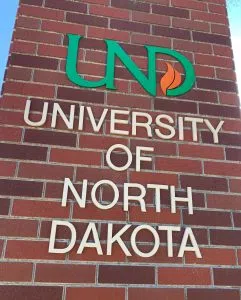Vermont
Kendyl’s Buns on the Run Serves Snowmobilers Trailside in the NEK

To get to the hottest hot dog stand in the Northeast Kingdom this winter, you’ll need a snowmobile — and plenty of snow dances to ensure good conditions.
Kendyl’s Buns on the Run, a seasonal business in Norton, is not accessible by car, which makes it completely weather dependent. But it’s an essential stop on a popular snowmobiling loop from Island Pond to Canaan (see “In the Loop,” page 36), whether for a quick snack or a chat with proprietor Kendyl Bell.
“She’s right on the trail but in the middle of nowhere,” said Mark Quinlan of South Burlington, who started snowmobiling six years ago when he borrowed a sled from Pat McCaffrey, also of South Burlington.
“It’s tucked right in the pines,” McCaffrey said. “You’d fly past it if you went too fast.”
The friends often stop at Kendyl’s while snowmobiling around the NEK during the roughly 10-week period when there’s enough snow to ride. Quinlan’s name is even written in “The Wiener’s Circle,” where Bell has regulars sign the side of the stand.
The idea for Kendyl’s Buns on the Run came from a garage party, as many ideas do during NEK winters. Bell, 30, had moved in December 2020 from San Francisco, where she was a fashion stylist, to Norton. Though her parents owned land there, she didn’t know many people and figured a hot dog stand was as good a way to make friends as any.
Opening the stand on the snowmobile trail on her parents’ property became Bell’s 2021 New Year’s resolution. By January 3, she and her mom had painted an old trailer — previously used as a hunting blind and a “she shed” — and dragged it into a freshly cleared spot in the woods. Bell got a local trail groomer to hang her hand-painted signs with arrows and opened for business.
A few seasons later, her business — which she now operates out of a minibus — is a regular weekend stop for snowmobilers in the know. Trails around Vermont are officially open from December 15 through April 15, depending on snowfall. Typically, Kendyl’s gets up and running in January.
“I tell people to get lost in the woods, go the long route and you’ll find me,” Bell said with a laugh.
Once you’re in the general area, though, she’s easy to spot. Bell drives an old Jeep lifted on track wheels, which she parks near the stand. She decks herself out in pink, from her hot-pink metallic snow pants to her sweater to the napkins she hands out.
The stand is an oasis for snowmobilers looking for warm food, a drink of water, a conversation break or a Porta-Potty. On a good snow day, it’s hosted more than 100 sleds at a time, Bell said. This winter, she will add a full-size bus that doubles as a warming hut and seating area.
“People are happy I’m out there, because I’m far from the restaurants and gas stations,” Bell said. “When they’re driving by and they forgot to pack a snack, it’s like, Bam. There’s this blond girl in a school bus handing out food.”
Bell’s menu features hot dogs, bratwurst, pulled pork and chili made with meat from her parents’ cows and pigs, chips, popcorn, granola bars, hot chocolate, coffee, water, and soda. Everything is available by donation.
“It’s just hot, good-quality, simple food,” she said. “Nobody wants to sit down and have a five-course meal. People want something quick that will warm them up until they get to whatever their next restaurant is.”
Bell views the stand’s honor-system, donation-based model as keeping things accessible to everyone. She reinvests some of the proceeds into the business and donates the rest to local snowmobile clubs and causes such as the American Cancer Society.
Bell also hosts special events for the community; in 2022, she organized a benefit for a local woman battling breast cancer, which drew a crowd of pink-bedecked sleds. She plans to host another breast cancer ride-in this year, and she’s once again participating in the Northeast Kingdom Snow Blasters’ Stake Out Cancer trailside fundraiser, offering $10 stake sponsorships.
Bell herself is still new to snowmobiling, and her personal motto is “go slow and be cautious.” She gets lots of advice from the strong community of riders who stop by, ranging from locals to Floridians and from young kids to a Canadian gentleman in his nineties.
“What I love about snowmobiling is, regardless of your age, your gender, how you identify, you can be out there having a great time,” Bell said. “Everybody’s happy when they’re on a sled.”
When they catch a glimpse of Bell’s bus ahead on the trail, they’re even happier.
In the Loop
Plenty of restaurants are accessible from Vermont Association of Snow Travelers trails — weather permitting. In heavy snow years, Mark Quinlan has started 100-mile snowmobile treks from the parking lot of the Dutch Mill Diner on Route 7 in Shelburne. VAST trails around the Champlain Valley take riders through farm fields across Spear Street and Dorset Street, down to Shelburne Pond and up Mount Philo. Quinlan has followed them all the way to Rosie’s Restaurant in Middlebury.
But in restaurant-rich Chittenden County, “the conditions are usually pretty sketchy,” he said. “It’s not like up in the Northeast Kingdom.”
More popular with riders is Island Pond, which Pat McCaffrey, who has been snowmobiling since 1989, called “the snowmobile capital of Vermont. You see traffic coming in from Massachusetts, New Hampshire, Pennsylvania and Connecticut — all coming in to park for the weekend and get at it, riding all through the trails up there.”
Hungry riders can find trail-accessible restaurants on the VAST website, which hosts a color-coded map showing conditions on the 5,000-plus miles of trails the nonprofit organization maintains around the state.
To ride on VAST trails, snowmobilers must insure and register their sleds; join a county and local club, choosing from the group’s 127 clubs statewide; purchase a trail pass; and take a snowmobile safety course if they were born after July 1, 1983, according to the VAST website. Passes are currently available at vtvast.org for $155 for an annual in-state registration through December 15.
For riders who are drawn to the “snowmobile capital” for its ample parking and trail access, Kendyl Bell suggested a dining itinerary. From Island Pond, they can stop at her Kendyl’s Buns on the Run in Norton before hitting April’s Maple in Canaan for lunch.
April Lemay’s multifaceted maple biz (6507 Route 114, Canaan, 266-9624, aprilsmaple.com) has been a destination for snow travelers since its launch in 2013. Even before it had a year-round on-site café, snowmobilers found their way to the sugarhouse to eat hot dogs and warm up by the boiling sap.
A decade later, April’s Maple is an official stop on the VAST system. Inside the shop, metal racks labeled “Snowmobile Gear Here” will be loaded with diners’ helmets once the snow piles up.
From fluffy pancakes to maple dogs with maple mustard, the maple-packed menu is perfect fuel for a winter adventure. But the pièce de résistance is the maple creemee, made with a 10 percent butterfat base and April’s Maple syrup and served in a cone coated with maple cream and rolled in maple crunch.
“It’s decadent beyond decadence,” Lemay told Seven Days last spring. Even on a cold, snowy day, that’s worth hitting the trail for.
From the sugarhouse, Bell suggested looping back to Island Pond for dinner at the Essex House & Tavern (138 Cross St., Island Pond, 723-9888, essexhouseandtavern.com), where she happens to work. The recently renovated circa-1866 hotel may be in the village of Island Pond, but it sits directly on the VAST trails — and across the street from the town’s eponymous lake.
At the Essex House & Tavern, helmets and snowsuits pile up “all over the tables in the restaurant dining room” during snowmobile season, Quinlan said. “That place is super hopping.”
The first-floor tavern’s lunch and dinner menu ranges from poutine to burgers to broiled maple-bourbon scallops; there’s regular live music and other entertainment, too. Upstairs lodging makes an easy home base for snowmobilers from out of town.
Working dinner at the Essex House can be “crazy busy,” Bell said. But she loves seeing the same people she saw in the woods earlier in the day.
“They’re supporting our small towns, eating everywhere and drinking everywhere,” she said.

Vermont
Vermont murder suspect arrested in New York

PORTLAND, N.Y. (WCAX) – Police say the suspect in a Vermont murder was arrested in New York on Wednesday.
Terrence Biggs Jr., 25, of Michigan, was wanted in the deadly shooting of Austin Rodriguez, 26, of Rutland. It happened at a home on Summer Street on April 22.
Investigators say state police in New York arrested Biggs during a traffic stop in Portland, New York, that is in western New York, early Wednesday morning.
Biggs is charged with second-degree murder.
We still don’t know what authorities think led to the shooting or what the connection was between the two men.
Copyright 2025 WCAX. All rights reserved.
Vermont
Vermont shelter celebrates 68 adoptions in one month

Vermont
A covered bridge quest in Vermont – VTDigger


This story by Tim Calabro was first published in The Herald on Sept. 11, 2025.
Phill Gatenby rolled over the Moxley Bridge in Chelsea with a plastic skeleton riding shotgun in his Jeep, having made the long drive from Brattleboro for an early morning visit. Just a year ago, the Manchester, England native — by way of Florida — had never laid eyes on a covered bridge. Now he’s smitten.
Gatenby recalled seeing a covered bridge while driving around and thinking, “Oh, that’s interesting. I’d never seen a covered bridge in my life before. Never really heard of them,” he said. “A couple days later, I was going to Townshend, and all of a sudden it’s the Dummerston Bridge, and I’m just like, different size, different shape, different color.”
He stopped for directions and as he got lost on the back roads, he saw more and more covered bridges.
What started as casual curiosity has evolved into a quest: visit and film all 100 of Vermont’s authentic, historic covered bridges and share the journey on YouTube in a series titled “Vermont’s 100 Covered Bridges.”
So far he’s been to 50 and cranked out 37 videos of his visits — one every Sunday.
The most recent set of episodes has focused on the covered bridges of Tunbridge, Chelsea, and Randolph.
No two are quite alike. From king and queen trusses to parallelogram-shaped spans built on bends, like some on the First Branch, Gatenby has come to appreciate their variety and character.
And, stepping back from the bridges, the entire scene fascinates Gatenby.
“I mentioned this in the Kingsbury Bridge [episode]. I was at the bridge and I looked, and you’ve got the green mountains in the background and rolling hills. Then you’ve got the farm with the — is it the corn towers? — the river and a covered bridge. And it just says, like, you can’t get more Vermont!”
Gatenby’s process is rigorous. Each episode takes hours to shoot and edit. He gets different angles — sometimes driving through a bridge three or four times for the right shot. He’s waded into rivers, climbed steep banks, and once filmed inside a long-retired bridge that had been turned into a town shed.
“I try and do something that’s consistent,” he says. “So it’s, you know, the same start, the same middle. I go in the river. I’ve been in every single river so far.”
Gatenby credits community access TV stations — first Okemo Valley TV in Ludlow and now Brattleboro Community TV — for helping him build his skills and loaning him equipment.
“They literally brilliantly sat down and five, six, seven weeks went through how you do it,” he recalled.
Gatenby’s episodes go out via Okemo Valley TV’s YouTube channel and have regular times on the Okemo Valley and Brattleboro TV stations.
Form, Function, History
Vermont once had more than 600 covered bridges, Gatenby noted, but flooding and age have winnowed down the number greatly. Now, 100 remain and many towns hold clusters of them.
Tunbridge, for example, boasts five (Flint, Larkin, Mill, Cilley and Howe), with the Moxley bridge just over the Chelsea line. Randolph has three (Kingsbury, Gifford, and Braley or Johnson), all of them along the Second Branch.
Gatenby pointed out that three of the First Branch bridges were built by the same person, Arthur Adams. That’s a phenomenon common to covered bridges, Gatenby noted. Oftentimes the same person who had the skills to build a bridge would become the area’s go-to expert.
As Gatenby visits each of the 100 covered bridges spread throughout the state, he points out the history and construction techniques used in each, particularly the suspension methods unique to covered bridges. Most covered bridges in the White River Valley make use of modified king trusses, posts fitted into a triangle, which provide strength to the structure. Some, like the Moxley bridge, use both king trusses and square queen trusses around them.
Vermont’s covered bridges aren’t just structural relics, though — they’re cultural icons.
Some have graced the silver screen, including the Kingsbury Bridge in Randolph, used by Alfred Hitchcock as scenery in his 1955 film “The Trouble with Harry.”
“North by Northwest” has its dramatic crop duster strafing Cary Grant, Gatenby jokes in one of his episodes before cutting to a humble, scenic shot featuring the South Randolph bridge. “Unfortunately, it wasn’t quite as glamorous as that!”
The Chiselville bridge in Sunderland — Gatenby’s favorite so far — featured in “Baby Boom,” Diane Keaton’s 1987 film, and a year later, in the 1988 Chevy Chase and Madolyun Smith Osborne comedy, the Upper Falls bridge in Weathersfield made for a memorable gag (“I wouldn’t go that way if I were you”).
Another memorable stop is East Corinth, where the prop bridge used in “Beetlejuice” was fabricated out of whole cloth for the two weeks of filming. “Thousands of people go there every year,” he said, noting that the set-piece, used now as a shed at a ski area, doesn’t count among the authentic and historic bridges he films.
Nor, he said, does the Quechee Bridge. Though it is often mistaken for a traditional covered bridge, it’s just a facade.
“It’s concrete and steel. There’s very little wood,” Gatenby said. “You see the wood on the outside and the roof.”
Traditional bridges are completely made from wood and use a variety of truss systems to strengthen the span.
Place and Purpose
Gatenby moved to Vermont from Florida in July of last year. He now lives in Brattleboro with his wife and works as a shift supervisor at a home for adults with mental health issues.
“I’m a trained youth worker in England,” he said, having spent years working for the Prince’s Trust, a charity founded by King Charles. His day job might be demanding, but the early hours leave room for exploration.
“Three o’clock to 11:30 at night, so the daytime allows me to spend time in the TV studio,” he says. That flexibility has enabled him to squeeze in long road trips, sometimes filming six or seven bridges in a single day. “I’ve got to do minimum six, seven bridges each trip now,” he added. “To make it worth it.”
This Sunday, the show’s 38th episode will be released.
“I’m doing a little special 50th episode,” he said, noting the halfway point in the 100-bridge journey. “That’s where I’m bringing in stuff like the Quechee bridge. Because people said, ‘Oh, you didn’t go to the Quechee.’”
As the series nears its midpoint, Gatenby’s audience is slowly growing, both online and in the communities he visits.
“It’s just amazing … you know, and I’m just visiting them all,” he said, “places that I wouldn’t have got to see otherwise.”
With 50 more bridges to go, Vermont’s covered bridge guy still has miles to travel and stories to uncover.Gatenby’s series of covered bridge videos can be watched on Okemo Valley and Brattleboro public television stations or found on YouTube.
-

 World1 week ago
World1 week agoTrump and Zelenskyy to meet as Poland pressures NATO on no fly zone over Ukraine
-

 Technology1 week ago
Technology1 week agoNew Evite phishing scam uses emotional event invitations to target victims
-

 Health1 week ago
Health1 week agoDiabetes risk quadruples with use of popular natural remedy, study finds
-

 Politics1 week ago
Politics1 week agoHouse plans Thursday vote on government funding bill to extend spending through November
-

 Business1 week ago
Business1 week agoDisney, Universal and Warner Bros. Discovery sue Chinese AI firm as Hollywood's copyright battles spread
-

 Health1 week ago
Health1 week agoWho Makes Vaccine Policy Decisions in RFK Jr.’s Health Department?
-

 Finance3 days ago
Finance3 days agoReimagining Finance: Derek Kudsee on Coda’s AI-Powered Future
-

 Lifestyle1 week ago
Lifestyle1 week agoBobbi Brown doesn’t listen to men in suits about makeup : Wild Card with Rachel Martin









/cloudfront-us-east-1.images.arcpublishing.com/gray/GKCEWM6TFVCHDCJ2DR5DYU3JS4.bmp)













